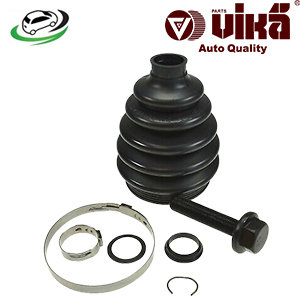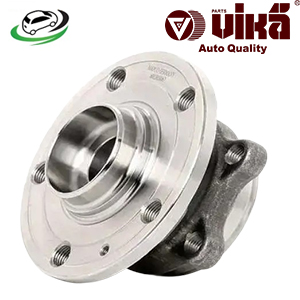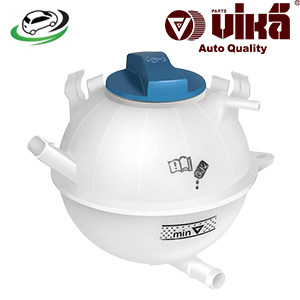-15%
Get Expansion Tank Cap VW Passat/Touareg/Passat (7L) / Audi A4 1K0121407A
The expansion tank cap, also known as the coolant reservoir cap, is a critical component in a vehicle’s cooling system. It plays a crucial role in maintaining the pressure and temperature within the cooling system, ensuring that the engine operates efficiently and reliably. Understanding the function, types, benefits, and maintenance of the expansion tank cap can help you keep your vehicle’s cooling system in optimal condition.
Function of the Expansion Tank Cap
- Pressure Regulation:
- Primary Role: The expansion tank cap regulates the pressure within the cooling system.
- Mechanism: It features a built-in pressure relief valve that opens at a specific pressure to release excess coolant and steam, preventing damage to the cooling system components.
- Temperature Control:
- Primary Role: The cap helps maintain the optimal operating temperature of the coolant.
- Mechanism: By regulating pressure, the cap ensures that the coolant remains in a liquid state at higher temperatures, improving heat dissipation and preventing overheating.
- Coolant Containment:
- Primary Role: The cap ensures that the coolant stays sealed within the expansion tank and the cooling system.
- Mechanism: It creates an airtight seal to prevent coolant from escaping and contaminants from entering the system.
- Expansion Management:
- Primary Role: The cap manages the expansion and contraction of the coolant as it heats up and cools down.
- Mechanism: It allows for the expansion of coolant into the expansion tank when the engine is hot and the contraction of coolant back into the system when the engine cools.
Types of Expansion Tank Caps
- Standard Pressure Caps:
- Description: These caps are designed to maintain a specific pressure level within the cooling system, usually measured in psi (pounds per square inch).
- Advantages: Simple design, cost-effective, and effective at maintaining system pressure.
- Disadvantages: Limited to the specific pressure rating and may not be suitable for all vehicle models.
- High-Pressure Caps:
- Description: High-pressure caps are designed for vehicles with higher cooling system pressure requirements.
- Advantages: Provides better cooling performance and can handle higher engine temperatures.
- Disadvantages: Higher cost and may require a specific pressure rating for compatibility.
- Expansion Tank Caps with Integrated Sensors:
- Description: These caps feature built-in sensors that monitor coolant levels and temperature.
- Advantages: Provides real-time monitoring and alerts for low coolant levels or overheating conditions.
- Disadvantages: More complex and expensive compared to standard caps.
- Pressure Relief Valve Caps:
- Description: Caps with pressure relief valves that open when the pressure exceeds a certain threshold.
- Advantages: Provides additional protection by releasing excess pressure to prevent system damage.
- Disadvantages: Requires periodic maintenance and replacement to ensure proper functioning.
- Ventilated Caps:
- Description: These caps include ventilation features to allow for the release of pressure and steam.
- Advantages: Helps manage pressure fluctuations and prevents excessive buildup.
- Disadvantages: May be less common and require specific compatibility with the vehicle’s cooling system.
Benefits of Properly Functioning Expansion Tank Caps
- Effective Pressure Management:
- Benefit: Properly functioning caps maintain the correct pressure within the cooling system.
- Explanation: Maintaining the right pressure helps prevent overheating and ensures efficient cooling performance.
- Prevention of Coolant Loss:
- Benefit: A well-sealed cap prevents coolant from escaping and maintains the proper level in the expansion tank.
- Explanation: Preventing coolant loss helps avoid overheating and ensures continuous engine cooling.
- Improved Engine Performance:
- Benefit: By regulating temperature and pressure, the expansion tank cap contributes to optimal engine performance.
- Explanation: Proper cooling helps the engine operate efficiently, leading to better performance and fuel economy.
- Extended Component Lifespan:
- Benefit: A properly functioning cap helps protect other cooling system components from damage.
- Explanation: By maintaining proper pressure and temperature, the cap reduces stress on the radiator, hoses, and other components.
- Reduced Risk of Overheating:
- Benefit: The cap helps prevent overheating by regulating pressure and temperature within the cooling system.
- Explanation: By ensuring the coolant remains in a liquid state and preventing excess pressure, the cap reduces the risk of engine overheating.
Symptoms of a Faulty Expansion Tank Cap
- Coolant Leaks:
- Symptom: Visible coolant leaks around the expansion tank or engine bay.
- Cause: A faulty or damaged cap may not seal properly, leading to coolant leaks.
- Consequence: Coolant loss can lead to overheating and engine damage.
- Overheating Engine:
- Symptom: The engine temperature gauge shows higher-than-normal readings or the engine overheats.
- Cause: A faulty cap may not maintain the correct pressure, leading to overheating.
- Consequence: Overheating can cause significant engine damage and reduced performance.
- Erratic Coolant Levels:
- Symptom: Fluctuating coolant levels or frequent need to top up the coolant reservoir.
- Cause: A faulty cap may allow coolant to escape or fail to maintain proper pressure.
- Consequence: Inconsistent coolant levels can lead to engine overheating and cooling system issues.
- Hissing or Steam from the Expansion Tank:
- Symptom: Hissing sounds or steam escaping from the expansion tank.
- Cause: Excessive pressure buildup due to a faulty cap or pressure relief valve.
- Consequence: Steam and hissing indicate potential overheating or pressure issues.
- Check Engine Light:
- Symptom: Illumination of the check engine light on the dashboard.
- Cause: A faulty cap may trigger engine sensors related to cooling system performance.
- Consequence: The check engine light indicates potential issues that may require further investigation.
Maintenance and Replacement Tips
- Regular Inspections:
- Tip: Periodically inspect the expansion tank cap for signs of wear, damage, or leaks. Check for cracks, corrosion, or gasket degradation.
- Frequency: Inspections should be part of routine vehicle maintenance, typically during oil changes or service intervals.
- Timely Replacement:
- Tip: Replace a faulty or damaged expansion tank cap promptly to prevent cooling system issues.
- Indication: Replace the cap if there are visible signs of damage, leakage, or persistent overheating problems.
- Use Quality Parts:
- Tip: Choose high-quality expansion tank caps that meet or exceed OEM specifications for your vehicle.
- Reason: Quality parts ensure reliable performance and proper pressure regulation, reducing the risk of future issues.
- Professional Assistance:
- Tip: Have a professional mechanic inspect and replace the expansion tank cap if you are unsure about the process or if complications arise.
- Reason: Professional assistance ensures proper installation and function of the cap.
- Check Coolant System Regularly:
- Tip: Monitor coolant levels and system performance regularly to identify potential issues early.
- Reason: Regular checks help maintain optimal engine temperature and prevent overheating.
- Ensure Proper Installation:
- Tip: Ensure that the expansion tank cap is properly installed and securely fastened.
- Reason: Proper installation prevents leaks and ensures effective pressure management.
- Monitor Temperature and Pressure:
- Tip: Pay attention to engine temperature and coolant system pressure as indicators of cap condition.
- Reason: Monitoring helps identify potential issues and ensure the cooling system operates efficiently.
Follow us on Facebook for more parts.



